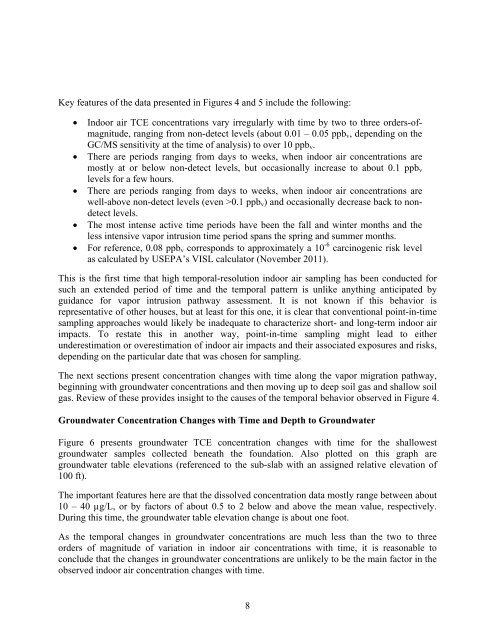INTERIM REPORT - Strategic Environmental Research and ...
INTERIM REPORT - Strategic Environmental Research and ...
INTERIM REPORT - Strategic Environmental Research and ...
Create successful ePaper yourself
Turn your PDF publications into a flip-book with our unique Google optimized e-Paper software.
Key features of the data presented in Figures 4 <strong>and</strong> 5 include the following:Indoor air TCE concentrations vary irregularly with time by two to three orders-ofmagnitude,ranging from non-detect levels (about 0.01 – 0.05 ppb v , depending on theGC/MS sensitivity at the time of analysis) to over 10 ppb v .There are periods ranging from days to weeks, when indoor air concentrations aremostly at or below non-detect levels, but occasionally increase to about 0.1 ppb vlevels for a few hours.There are periods ranging from days to weeks, when indoor air concentrations arewell-above non-detect levels (even >0.1 ppb v ) <strong>and</strong> occasionally decrease back to nondetectlevels.The most intense active time periods have been the fall <strong>and</strong> winter months <strong>and</strong> theless intensive vapor intrusion time period spans the spring <strong>and</strong> summer months.For reference, 0.08 ppb v corresponds to approximately a 10 -6 carcinogenic risk levelas calculated by USEPA’s VISL calculator (November 2011).This is the first time that high temporal-resolution indoor air sampling has been conducted forsuch an extended period of time <strong>and</strong> the temporal pattern is unlike anything anticipated byguidance for vapor intrusion pathway assessment. It is not known if this behavior isrepresentative of other houses, but at least for this one, it is clear that conventional point-in-timesampling approaches would likely be inadequate to characterize short- <strong>and</strong> long-term indoor airimpacts. To restate this in another way, point-in-time sampling might lead to eitherunderestimation or overestimation of indoor air impacts <strong>and</strong> their associated exposures <strong>and</strong> risks,depending on the particular date that was chosen for sampling.The next sections present concentration changes with time along the vapor migration pathway,beginning with groundwater concentrations <strong>and</strong> then moving up to deep soil gas <strong>and</strong> shallow soilgas. Review of these provides insight to the causes of the temporal behavior observed in Figure 4.Groundwater Concentration Changes with Time <strong>and</strong> Depth to GroundwaterFigure 6 presents groundwater TCE concentration changes with time for the shallowestgroundwater samples collected beneath the foundation. Also plotted on this graph aregroundwater table elevations (referenced to the sub-slab with an assigned relative elevation of100 ft).The important features here are that the dissolved concentration data mostly range between about10 – 40 µg/L, or by factors of about 0.5 to 2 below <strong>and</strong> above the mean value, respectively.During this time, the groundwater table elevation change is about one foot.As the temporal changes in groundwater concentrations are much less than the two to threeorders of magnitude of variation in indoor air concentrations with time, it is reasonable toconclude that the changes in groundwater concentrations are unlikely to be the main factor in theobserved indoor air concentration changes with time.8

















